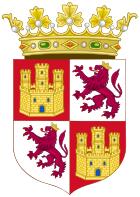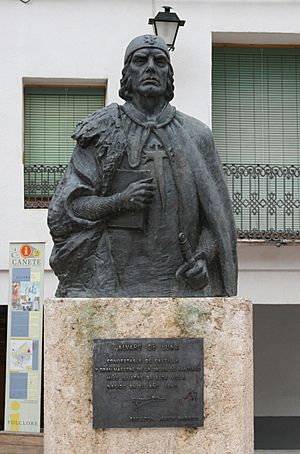House of Trastámara facts for kids
| House of Trastámara Casa de Trastámara |
|||
|---|---|---|---|
Quick facts for kids  Armorial of Trastámara |
|||
| Country: | Crown of Castile, Crown of Aragon | ||
| Parent House: | Castilian House of Burgundy (illegitimate) | ||
| Titles: | * King of Castile and León
|
||
| Founder: | Henry II of Castile | ||
| Final Ruler: | Joanna of Castile | ||
| Founding Year: | 1366 | ||
| Dissolution: | 1555 | ||
The House of Trastámara (in Spanish, Aragonese, and Catalan: Casa de Trastámara) was a powerful royal dynasty. They first ruled in the Crown of Castile and later expanded their power to the Crown of Aragon. This happened from the late Middle Ages into the early modern period.
This family was a branch of the Castilian House of Burgundy. They came to power in Castile in 1369. This was after Henry of Trastámara won a civil war against his half-brother, Peter I. The war lasted from 1351 to 1369. Many nobles and some clergy supported Henry. This change in rulers led to more social problems in Castile. There was growing dislike towards Jewish people, made worse by economic difficulties. This tension led to serious unrest in 1391.
Later, the Crown of Aragon faced a problem when its king, Martin of Aragon, died without a clear heir. In 1412, the Compromise of Caspe decided that Ferdinand of Antequera, a member of the House of Trastámara, would become the new king of Aragon.
The marriage of the Catholic Monarchs, Isabella I of Castile and Ferdinand II of Aragon, was very important. Both were from the House of Trastámara. Their marriage meant that Castile and Aragon were ruled together, creating a dynastic union. Although there was a conflict called the War of the Castilian Succession, Isabella's claim to the throne of Castile was confirmed. The Trastámara dynasty was later replaced by the House of Habsburg. This happened when Charles V became king of Castile and Aragon in 1516. His mother, Joanna, who was not able to rule, lived until 1555.
Contents
The Trastámaras Rise to Power
Peter I and Henry of Trastámara
When King Alfonso XI of Castile died in 1350, his oldest son, Peter, became King Peter I. Peter was the son of Alfonso and his wife, Maria of Portugal. However, Alfonso also had many children with Eleanor of Guzman. These illegitimate children were known as the Trastámaras. They quickly became rivals to Peter. Peter's enemies called him "Peter the Cruel" because of his actions, including political killings. Peter's mother also had Eleanor of Guzman arrested and executed, which increased the bad feelings.
Peter I fought against Henry of Trastámara and his supporters in 1356. Peter won this battle. He defeated his rivals again at Nájera in 1360 and had his half-brothers Juan and Pedro killed. Henry had been protected by Aragon, but he had to flee to France when Castile and Aragon made a peace treaty in 1360.
Henry of Trastámara gained support across Castile. People remembered his connection to Alfonso XI. Henry formed an alliance with Aragon and France. He also got help from French soldiers led by Bertram Du Guesclin. In 1365, Henry made another attempt to take the Castilian throne. Peter I got help from Edward the Black Prince, the son of Edward III of England. Peter promised Edward land if he helped defend his crown. On April 13, 1367, Peter and Edward's forces strongly defeated Henry's armies. They also captured Bertram Du Guesclin.
Edward the Black Prince became ill. He was also unhappy with Peter's actions and delays in fulfilling promises. So, the English forces left Castile. In March 1369, Henry's forces invaded Castile again. They still had support from France and Aragon, and from important cities in Castile. Henry's army fought Peter's army. Henry of Trastámara himself was responsible for the death of his brother, Peter I of Castile.
Henry II Becomes King
After the death of his half-brother, Peter I, Henry of Trastámara became King Henry II of Castile. Under Henry, a new group of nobles became very powerful. They received large land grants and many royal privileges. This rise of a new noble class caused some unrest in Castile. These nobles wanted to get back family lands and were willing to do whatever it took. Despite these problems, Henry's forces successfully defended Castile from invasions. These invasions came from Portugal, Navarre, and the Granada.
Henry made an important agreement with Peter IV, the ruler of Aragon. They decided their children would marry. Henry's son, John, married Peter IV's daughter, Eleanor, on June 18, 1375. This marriage eventually led to the Trastámara family controlling both Castile and Aragon. This meant they ruled most of the Iberian Peninsula. Eleanor died in 1382, after having three children.
The Trastámaras Rule Many Lands
When Henry II died in 1379, his son John became King John I of Castile. During his time as king, John married Beatrice, the daughter of King Ferdinand I of Portugal. Because of this marriage, John tried to claim the throne of Portugal when Ferdinand I died in 1383. If he had succeeded, it could have united all of the Iberian Peninsula. John died unexpectedly in 1390.
After John's sudden death, his oldest son Henry became King Henry III. He was very young, only twelve years old. He waited only two years to take full control of the throne in 1393, at age fourteen. This was a time of much violence against Jewish people in Castile. One of the young king's achievements was taking control of the Canary Islands. This gave Castile a holding in the Atlantic Ocean. In 1406, Henry died at age 27 while planning a response to an invasion by Granada's forces in Murcia.
John II, Henry III's son, was the only heir when Henry died in 1406. But John was only two years old. Henry's brother, Ferdinand, served as regent, along with John's mother, Catherine of Lancaster.
While Ferdinand was regent, he was chosen to rule Aragon. This happened because of his family connection to the Aragonese throne. The Compromise of Caspe in 1412 made him King Ferdinand I of Aragon. Now, the Trastámara family ruled in both Castile and Aragon.
Conflicts Within the Trastámara Family
John II and Don Álvaro
John II became king when his mother died in 1418. He was now a cousin to the King of Aragon, Alfonso V, who had become king after Ferdinand I died. John married Maria, Alfonso V's sister. Alfonso V had already married John's sister, Maria. This meant the two kings were cousins and brothers-in-law twice over. John II was also a cousin and brother-in-law to Alfonso's brothers, John and Henry. These brothers were known as the Infantes of Aragon. They had received large amounts of land in Castile when their father was regent during John II's childhood.
John II did not have strong control over Castile. The kingdom became a place where nobles fought for power and influence. In 1420, just two years after becoming king, John was captured by his cousin Infante Henry. Henry ruled for John for much of the year. John was able to escape with the help of his friend, Álvaro de Luna, known as Don Alvaro. Don Alvaro later became a royal favorite.
In 1429, Alfonso V ordered the Infantes to attack Castile. Don Alvaro, who was now John II's constable, agreed to a truce. This truce was a victory for Castile, as the Aragonese branch of the Trastámaras was removed from Castile. John II's power continued to weaken after this. He eventually gave all power to Don Alvaro, who created a government run by a few powerful nobles. Don Alvaro lost this power in 1439 to nobles who were allied with Alfonso V. In 1443, John II was captured again by Infante John of Aragon. This caused great disorder in Castile. This confusion ended in 1445. A group of nobles who supported the king, led by Don Alvaro, won a battle at Olmedo. Infante Henry was killed in this battle.
In 1453, Don Álvaro was publicly executed for charges of tyranny. In July of the next year, John II died. His son Henry became King Henry IV of Castile.
Henry IV and Isabella I
Henry IV of Castile was not a popular ruler. This was partly because he liked Moorish fashion and disagreed with fighting Granada. He married Blanche, daughter of John II of Aragon, in 1440 when he was 15. John II had become King of Aragon after his brother Alfonso V of Aragon died. This marriage did not work out. Henry remarried in 1455 to Joan of Portugal. Queen Joan gave birth to Princess Joan in 1462. The Cortes (a type of parliament) recognized her as Henry's rightful successor. In 1464, powerful noble families claimed that Princess Joan was the daughter of one of Henry's favorites, The 1st Duke of Alburquerque.
These powerful noble families eventually forced Henry IV to give power to his brother Alfonso in 1465. But Alfonso died suddenly a month later. While people were fighting over who should be king, Henry's wife Joan became pregnant again. This happened while she was being held by a noble family. This behavior further weakened her daughter Princess Joan's claim to the throne. It opened the way for Henry's half-sister Isabella to take power.
The Pact of Guisando and the War of Succession
The Pact of the Toros de Guisando was signed in 1468. It named Isabella as the heir to Henry's throne. In return, Isabella and the nobles promised loyalty to Henry. A quick marriage for Isabella was part of the agreement. However, Henry objected to her marriage in 1469 to Ferdinand. Ferdinand was the King of Sicily and the heir to the Aragonese throne. Henry saw this marriage as a break of the pact. He again named his daughter Joan as his heir. A civil war followed for the next ten years. Isabella's forces eventually won with help from Aragon. This made her queen and united the crowns of Aragon and Castile.
Family tree
| House of Trastámara family tree | |||||||||||||||||||||||||||||||||||||||||||||||||||||||||||||||||||||||||||||||||||||||||||||||||||||||||||||||||||||||||||||||||||||||||||||||||||||||||||||||||||||||||||||||||||||||||||||||||||||||||||||||||||||||||||||||||||||||||||||||||||||||||||||||||||||||||||||||||||||||||||||||||||||||||||||||||||||||||||||||||||||||||||||||||||||||||||||||||||||||||||||||||||||||||||||||||||||||||||||||||||||||||||||||||||||||||||||||||||||||||||||||||||||||||||||||||||||||||||||||||||||||||||||||||||||||||||||||||||||||||||||||||||||||||||||||||||||||||||||||||||||||||||||||||||||||||||||||||||||||||||||||||||||||||||||||||||||||||||||||||||||||||||||||||||||||||||||||||||||||||||||||||||||||||||||||||||||||||||||||||||||||||||||||||||||||||||||||||||||||||||||||||||||||||||||||||||||||||||||||||||||||||||||||||||||||||||||||||||||||||||||||||||||||||||||||||||||||||||||||||||||||||||||||||||||||||||||||||||||||||||||||||||||||||||||||||||||||||||||||||||||||||||||||||||||||||||||||||||||||
|---|---|---|---|---|---|---|---|---|---|---|---|---|---|---|---|---|---|---|---|---|---|---|---|---|---|---|---|---|---|---|---|---|---|---|---|---|---|---|---|---|---|---|---|---|---|---|---|---|---|---|---|---|---|---|---|---|---|---|---|---|---|---|---|---|---|---|---|---|---|---|---|---|---|---|---|---|---|---|---|---|---|---|---|---|---|---|---|---|---|---|---|---|---|---|---|---|---|---|---|---|---|---|---|---|---|---|---|---|---|---|---|---|---|---|---|---|---|---|---|---|---|---|---|---|---|---|---|---|---|---|---|---|---|---|---|---|---|---|---|---|---|---|---|---|---|---|---|---|---|---|---|---|---|---|---|---|---|---|---|---|---|---|---|---|---|---|---|---|---|---|---|---|---|---|---|---|---|---|---|---|---|---|---|---|---|---|---|---|---|---|---|---|---|---|---|---|---|---|---|---|---|---|---|---|---|---|---|---|---|---|---|---|---|---|---|---|---|---|---|---|---|---|---|---|---|---|---|---|---|---|---|---|---|---|---|---|---|---|---|---|---|---|---|---|---|---|---|---|---|---|---|---|---|---|---|---|---|---|---|---|---|---|---|---|---|---|---|---|---|---|---|---|---|---|---|---|---|---|---|---|---|---|---|---|---|---|---|---|---|---|---|---|---|---|---|---|---|---|---|---|---|---|---|---|---|---|---|---|---|---|---|---|---|---|---|---|---|---|---|---|---|---|---|---|---|---|---|---|---|---|---|---|---|---|---|---|---|---|---|---|---|---|---|---|---|---|---|---|---|---|---|---|---|---|---|---|---|---|---|---|---|---|---|---|---|---|---|---|---|---|---|---|---|---|---|---|---|---|---|---|---|---|---|---|---|---|---|---|---|---|---|---|---|---|---|---|---|---|---|---|---|---|---|---|---|---|---|---|---|---|---|---|---|---|---|---|---|---|---|---|---|---|---|---|---|---|---|---|---|---|---|---|---|---|---|---|---|---|---|---|---|---|---|---|---|---|---|---|---|---|---|---|---|---|---|---|---|---|---|---|---|---|---|---|---|---|---|---|---|---|---|---|---|---|---|---|---|---|---|---|---|---|---|---|---|---|---|---|---|---|---|---|---|---|---|---|---|---|---|---|---|---|---|---|---|---|---|---|---|---|---|---|---|---|---|---|---|---|---|---|---|---|---|---|---|---|---|---|---|---|---|---|---|---|---|---|---|---|---|---|---|---|---|---|---|---|---|---|---|---|---|---|---|---|---|---|---|---|---|---|---|---|---|---|---|---|---|---|---|---|---|---|---|---|---|---|---|---|---|---|---|---|---|---|---|---|---|---|---|---|---|---|---|---|---|---|---|---|---|---|---|---|---|---|---|---|---|---|---|---|---|---|---|---|---|---|---|---|---|---|---|---|---|---|---|---|---|---|---|---|---|---|---|---|---|---|---|---|---|---|---|---|---|---|---|---|---|---|---|---|---|---|---|---|---|---|---|---|---|---|---|---|---|---|---|---|---|---|---|---|---|---|---|---|---|---|---|---|---|---|---|---|---|---|---|---|---|---|---|---|---|---|---|---|---|---|---|---|---|---|---|---|---|---|---|---|---|---|---|---|---|---|---|---|---|---|---|---|---|---|---|---|---|---|---|---|---|---|---|---|---|---|---|---|---|---|---|---|---|---|---|---|---|---|---|---|---|---|---|---|---|---|---|---|---|---|---|---|---|---|---|---|---|---|---|---|---|---|---|---|---|---|---|---|---|---|---|---|---|---|---|---|---|---|---|---|---|---|---|---|---|---|---|---|---|---|---|---|---|---|---|---|---|---|---|---|---|---|---|---|---|---|---|---|---|---|---|---|---|---|---|---|---|---|---|---|---|---|---|---|---|---|---|---|---|---|---|---|---|---|---|---|---|---|---|---|---|---|---|---|---|---|---|---|---|---|---|---|---|---|---|---|---|---|---|---|---|---|---|---|---|---|---|---|---|---|---|---|---|---|---|---|---|---|---|---|---|---|---|---|---|---|---|---|---|---|---|---|---|---|---|---|---|---|---|---|---|---|---|---|---|---|---|---|---|---|---|---|---|---|---|---|---|---|---|---|---|---|---|---|---|---|---|---|---|---|---|---|---|---|---|---|---|---|---|---|---|---|---|---|---|---|---|---|---|---|---|---|---|---|---|---|---|---|---|---|---|---|---|---|---|---|---|---|---|---|---|---|---|---|---|---|---|---|---|---|---|---|---|---|---|---|---|---|---|---|---|---|---|
|
Monarchs of Castile: ; monarchs of Aragon: ; monarchs of Navarre: ; monarchs of Castile & Aragon (i.e. Spain): ; monarchs of Naples only: ;
|
|||||||||||||||||||||||||||||||||||||||||||||||||||||||||||||||||||||||||||||||||||||||||||||||||||||||||||||||||||||||||||||||||||||||||||||||||||||||||||||||||||||||||||||||||||||||||||||||||||||||||||||||||||||||||||||||||||||||||||||||||||||||||||||||||||||||||||||||||||||||||||||||||||||||||||||||||||||||||||||||||||||||||||||||||||||||||||||||||||||||||||||||||||||||||||||||||||||||||||||||||||||||||||||||||||||||||||||||||||||||||||||||||||||||||||||||||||||||||||||||||||||||||||||||||||||||||||||||||||||||||||||||||||||||||||||||||||||||||||||||||||||||||||||||||||||||||||||||||||||||||||||||||||||||||||||||||||||||||||||||||||||||||||||||||||||||||||||||||||||||||||||||||||||||||||||||||||||||||||||||||||||||||||||||||||||||||||||||||||||||||||||||||||||||||||||||||||||||||||||||||||||||||||||||||||||||||||||||||||||||||||||||||||||||||||||||||||||||||||||||||||||||||||||||||||||||||||||||||||||||||||||||||||||||||||||||||||||||||||||||||||||||||||||||||||||||||||||||||||||||
See also
 In Spanish: Casa de Trastámara para niños
In Spanish: Casa de Trastámara para niños
- List of Navarrese monarchs from the House of Trastámara
- Navarre monarchs family tree



